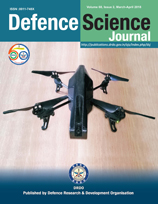Epoxy-glass Microballoon Syntactic Foams for Blast Mitigating Applications
DOI:
https://doi.org/10.14429/dsj.68.12048Keywords:
Syntactic foams, High strain rate, Blast load, Shock tubeAbstract
Polymeric syntactic foams refer to a class of cellular material created using preformed hollow spheres bound together with a polymeric matrix. These cellular materials possess exceptional ability to respond against high impact dynamic loads. This paper is an attempt to fabricate polymeric syntactic foams of epoxy containing hollow glass microballoon at varying loading (40 % - 60 %) and explore their potential towards blast mitigation. The tensile, compressive and flexural strength were found to be inversely proportional to the microballoon loading in the quasi-static regime. The strain rate sensitivity of the foams was confirmed by performing high strain rate studies using split hopkinson pressure bar. The flow stress of these foams was found to increase with increasing strain rates. The syntactic foams were subjected to controlled transient blast loadings using a shock tube. The samples remained intact and no strain was observed on the strain gauge, even under a blast load of ~ 90 psi, which clearly highlight their potential as core materials for blast mitigating applications.Downloads
Published
2018-03-13
How to Cite
Ullas, A., Sharma, P. K., Chandel, P., Sharma, P., Kumar, D., Kumar, D., & Roy, P. K. (2018). Epoxy-glass Microballoon Syntactic Foams for Blast Mitigating Applications. Defence Science Journal, 68(2), 210–217. https://doi.org/10.14429/dsj.68.12048
Issue
Section
Materials Science & Metallurgy
License
 Where otherwise noted, the Articles on this site are licensed under Creative Commons License: CC Attribution-Noncommercial-No Derivative Works 2.5 India
Where otherwise noted, the Articles on this site are licensed under Creative Commons License: CC Attribution-Noncommercial-No Derivative Works 2.5 India


